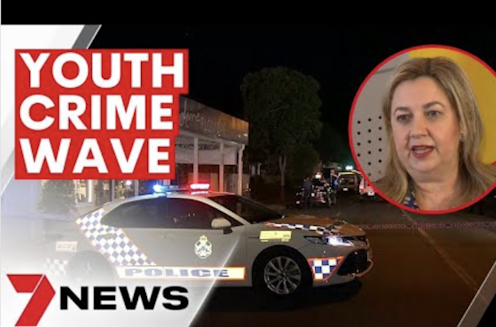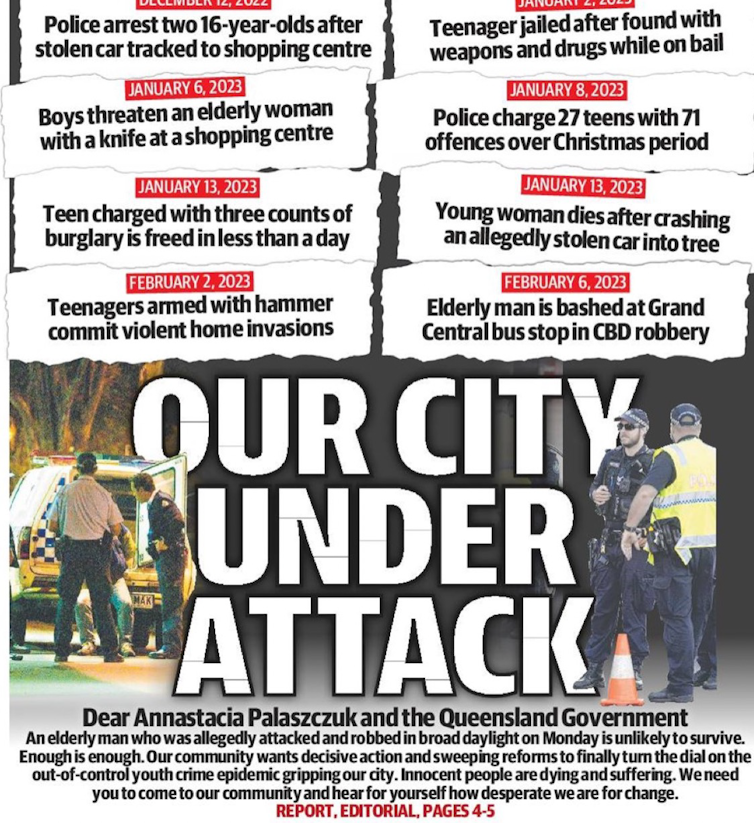
Media outlets across Australia have carried headlines about a “youth crime crisis” in recent months. While drawn from actual events, often involving serious criminality and antisocial behaviour, these often sensational reports have the same narrative subtext. The story is one of “bad kids” doing bad things in otherwise “good communities”.
Our understanding, as a society, of who we are is informed in part by the media. What the youth crime crisis is and who we understand young offenders to be corresponds with media framings of these individuals and their actions.
More often than not, the reports present a “good-bad” binary: where “bad” young people who do bad things should be locked up to protect “good” people. It’s a basic, albeit understandable, reaction that makes sense in terms of a logic of punishment and retribution.
For the Youth Community Futures research project, we have been working with groups of young people to explore how they engage with the community and how they feel about it. Our young people have said they are increasingly fearful and are conscious of being perceived negatively. They do not feel accepted by others or their communities.
In short, these young people feel they are viewed as “bad” because they are young. And when young people feel marginalised, the outcomes include withdrawing and becoming socially isolated. It also increases the potential for problematic anti-social behaviour – including crime.

Read more: The NT's tough-on-crime approach won't reduce youth offending. This is what we know works
Fuelling the fear of'folk devils’
There is, of course, far more to the situation. Research shows young people who engage in criminal activity are likely to have been victims themselves. The lives of many young offenders are complicated. Yet rarely are these situations and backgrounds factored into the media reports.
Beyond the circumstances of young offenders themselves, a further problem exists. When young people, as a defined social category, are presented in the media in such narrow terms, it becomes difficult to see them as anything other than threatening and dangerous.
Stanley Cohen’s seminal sociology of British youth from the 1960s demonstrates the ways that public sentiment often divorces from the facts of situations to create “folk devils”. When portrayals of young people, including those in the media, present them as threatening and menacing, it follows that public sentiment will be cast in similar ways.
Read more: Three ways teenagers are misrepresented in society
Blinding us to the complexities
The challenge then is that it becomes difficult to understand the complexities of the situation and show empathy. This applies not only to “bad” young people, but to others who aren’t engaged in such problematic behaviour but who are caught within the narrow perceptions of who young people are.
This forms the central claim in our argument: the current youth crime crisis is as much a media-generated problem as it is a criminological problem. The way we understand and position young people as “folk devils” runs the risk of invoking fear and trepidation. Such fears lead the public to categorise all young people in problematic ways while failing to understand the complex challenges young people encounter.
More complex social narratives are required if we are to avoid a situation in which young people feel marginalised.
Read more: 'I go for the food': what children and young people told us about why they steal from houses
So, what is the solution?
We need to develop deeper and more accurate understandings of who our young people are. This applies particularly to those who are caught up in criminality and anti-social behaviour.
Most young people do not set out in life to be “bad”. Their problematic behaviours are likely to be the result of complex challenges. Once we accept that, we have a responsibility to seek deeper understandings of the situations our young people face.
Sensationalist headlines that feed on public fears are not helpful. These might sell newspapers, but they do not make us stronger as a society. They create folk devils out of young people who probably require support, and they produce a fearful community.
We need to move beyond easy explanations and simple distinctions. While it is horrendous that homes are being broken into and cars stolen, understanding that the young people engaged in these activities are likely also victims themselves is important for realising that we, as a society, have an obligation to all individuals.
We need to ask why young offenders are in this situation. Once we acknowledge the importance of a better understanding of their circumstances, we can start to meaningfully resolve these social problems before they occur.
Andrew Hickey receives funding from the Queensland government. The authors acknowledge the contributions to the research by Stewart Riddle, Alarnah McKee, Danika Skye and Celmara Pocock.
Rachael Wallis receives funding from the Queensland government.
This article was originally published on The Conversation. Read the original article.







